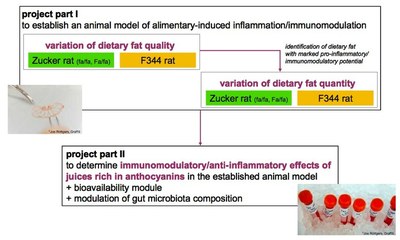Teilprojekt 5 - Anthocyane im Tiermodell
Bioverfügbarkeit und immunologische Wirkungen von Anthocyanen im Tiermodell
Workpackage 5:
Bioavailability and immune effects of anthocyanins in the animal model.
Project team: Prof. Dr. B. Watzl, PD Dr. Achim Bub, Dr. Stephan Barth, Dr. S. Seifert, D. Graf, Max Rubner-Institut, Karlsruhe
Email: bernhard.watzl@mri.bund.de
Background
Inflammation is the underlying disorder in obesity-associated diseases, e.g. in cardiovascular as well as in some cancer diseases. Anthocyanins are a widespread class of water-soluble flavonoids and are largely present in specific foods, especially berries. In vitro as well as animal studies suggest, that anthocyanins possess an immunosuppressive/antiinflammatory potential, but the underlying mechanisms are still unknown.
Aims
The major aim of this project is to determine immunomodulatory/anti-inflammatory effects of juices rich in anthocyanins in a model of diet-induced inflammation. Both aspects will be investigated systemically as well as locally in gut-associated lymphoid tissues. Above that, the bioavailability of anthocyanins from berries will be assessed. To this aim, anthocyanins and metabolites will be quantified in plasma, urine, feces, liver, and kidney (in cooperation with workpackage 2). Furthermore, data on the effects of juices rich in anthocyanins on the intestinal microbiota will be recorded (in cooperation with workpackage 3).
The results of workpackage 5 can give insight into whether and how anthocyanins influence the immune system, systemic and/or via the gut-associated immune system. If the hypothesis of the immunosuppressive/anti-inflammatory effect of anthocyanin-rich food can be proven, recommendations of a high intake can be implemented in future dietary recommendations for subjects with inflammatory conditions.
Structure of workpackage 5:

